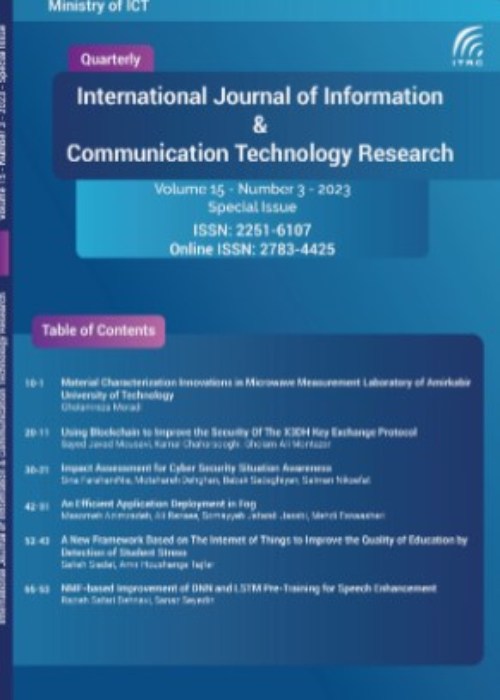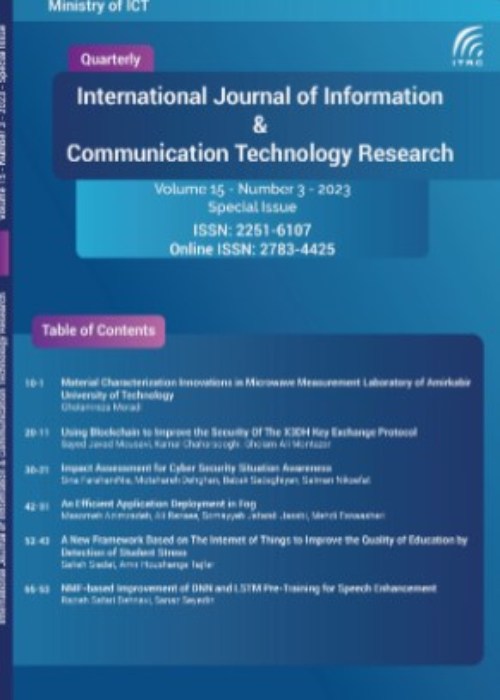فهرست مطالب

International Journal Information and Communication Technology Research
Volume:15 Issue: 4, Autumn 2023
- تاریخ انتشار: 1402/10/02
- تعداد عناوین: 6
-
-
Pages 1-8
An 8 port narrowband Radial Power Combiner (RPC) with excellent combining efficiency is presented. A novel useful criteria for optimal design of the RPC is developed and the design is studied based on it. Also to provide a reliable, tolerant and cost effective mechanical design, the mechanical structure of the combiner is simplified for fabrication and assembly. The designed RPC has standard waveguide ports at inputs, so it can be used in standard high power applications without any adaptors. The physical structure simplicity guarantees the product reliability for industrial high power applications. The optimized RPC design is fabricated and the measurement results are presented. The back-to-back measurement setup using customized through lines and two identical combiners have helped to take into account other efficiency degrading phenomena like port junctions’ discontinuity. It is shown that simulated power combining efficiency of 99% and measured power combining efficiency of 97.7 % is achieved.
Keywords: Combining efficiency, Radial power combiner, High power amplifier, graceful degradation, rectangular waveguide -
Pages 8-14
In this paper, a probe for measuring radio-frequency electric fields in the environment is designed and presented. These electric fields consist of multi cellular technology (2G, 3G and 4G), including four bands: GSM900, GSM1800, 3G2100 and LTE2600. This device, called the MCT electric probe, is realized by three orthogonal antennas, in connection to frequency multiplexer circuits and detectors. The proposed antenna is a 3-D multi-branch monopole antenna, and these orthogonal antennas can receive the electric fields in all directions uniformly and isotopically. The proposed multiplexer can separate the received signals into four narrowband and has the ability to remove out-of-band signals. The detector is able to convert the fields received from the antenna and multiplexer sections to suitable DC voltages for amplifying and digital processing. Finally, the designed MCT electric probe is fabricated and tested. The measurements confirm the proper operation of the probe in terms of dynamic range, accuracy, sensitivity, and the linearity and isotropicity of the received electric fields.
Keywords: Electric probe, Cellular Network, multiplexer, detector -
Pages 15-24
New emerging industries, such as vertical markets, need diverse networking requirements that the next generation mobile networks have to support effectively. Network slicing is the basic solution to meet the diverse requirements of various services over a common network infrastructure. Different network slicing architectures have been proposed; however, to the best of our knowledge, there is no unified architecture to cover all aspects of technology. In this paper, we propose a complete network slicing architecture based on 3GPP 5G system that addresses a unified end-to-end approach. We show how this architecture can create and operate various slices in the core and radio access sections using SDN controllers, virtualization, NFV MANO, and 3GPP management functions. We do compare our proposed one with some famous network-slicing architectures. The Comparison Results show that our proposed architecture is complete and covers all the aspects of network slicing. It uses NFV management and orchestration capabilities and SDN controllers while being compatible with 3GPP Service-Based architecture. It also provides life cycle management of network slices in both creation and operation phases in both core and radio access domains of the 5G network. In addition, we have included a functional RAN layer split to lay the corresponding layers in centralized or distributed units according to the requirements of each eMBB, mMTC, or URLLC slice.
Keywords: Network Slicing, 5G, SDN, NFV, Management, Orchestration, System Architecture -
Pages 25-31
Facial expression recognition using deep learning methods has been one of the active research fields in the last decade. However, most of the previous works have focused on the implementation of the model in the laboratory environment, and few researchers have addressed the real-world challenges of facial expression recognition systems. One of the challenges of implementing the face recognition system in the real environment (e.g. webcam or robot) is to create a balance between accuracy and speed of model recognition. Because, increasing the complexity of the neural network model leads to an increase in the accuracy of the model, but due to the increase in the size of the model, the recognition speed of the model decreases. Therefore, in this paper, we propose a model to recognize the seven main emotions (Happiness, sadness, anger, surprise, fear, disgust and natural), which can create a balance between accuracy and recognition speed. Specifically, the proposed model has three main components. First, in the feature extraction component, the features of the input images are extracted using a combination of normal and separable convolutional networks. Second, in the feature integration component, the extracted features are integrated using the attention mechanism. Finally, the merged features are used as the input of the multi-layer perceptron neural network to recognize the input facial expression. Our proposed approach has been evaluated using three public datasets and images received via webcam
Keywords: Facial expression recognition, Attention mechanism, Separable convolutional -
Pages 32-40
— Reading traditional meters is always time-consuming and expensive. Using smart meters solves most of the problems existing in the traditional meter network. Smart meters are an advanced form of traditional electro-mechanical devices that can measure energy consumption in real-time and communicate through one or more wired or wireless networks. These devices can communicate from long distances and get changed, making them an easy target for attacks. This paper studies the security mechanisms in smart meters networks and suggests some security solutions in such networks. We have developed software for managing the information of smart meters and controlling them remotely. In this paper, we present the implemented security mechanisms in the developed smart meter management software. The proposed solutions for enhancing the security of this software include implementing the authentication system, enabling user management, and defining different access levels to prevent users from connecting without proper authentication and access control in the developed software. Moreover, hashing the password with a random salt technique is implemented for securing the database. Furthermore, we have secured the software platform to prevent web attacks such as Clickjacking and CSRF attacks.
Keywords: Internet of Things, Smart Meters, Management, Security, Authentication -
Pages 41-52
As a growing of IoT devices, new computing paradigms such as fog computing are emerging. Fog computing is more suitable for real-time processing due to the proximity of resources to IoT layer devices. Service providers must dynamically update the hardware and software parameters of the network infrastructure. Software defined network (SDN) proposed as a new network paradigm, whose separate control layer from data layer and provides flexible network management. This paper presents a software-defined fog platform to host real-time applications in IoT. Then, we propose a novel resource allocation method. This method involves scheduling multi-node real-time task graphs over the fog to minimize task execution latency. The proposed method is designed to benefit the centralized structure of SDN. The simulation results show that the proposed method can find near to optimal solutions in a very lower execution time than the brute force method.
Keywords: Software-defined network, fog computing, Multi-nodes weighted directed task graph, Task assigning, task offloading


